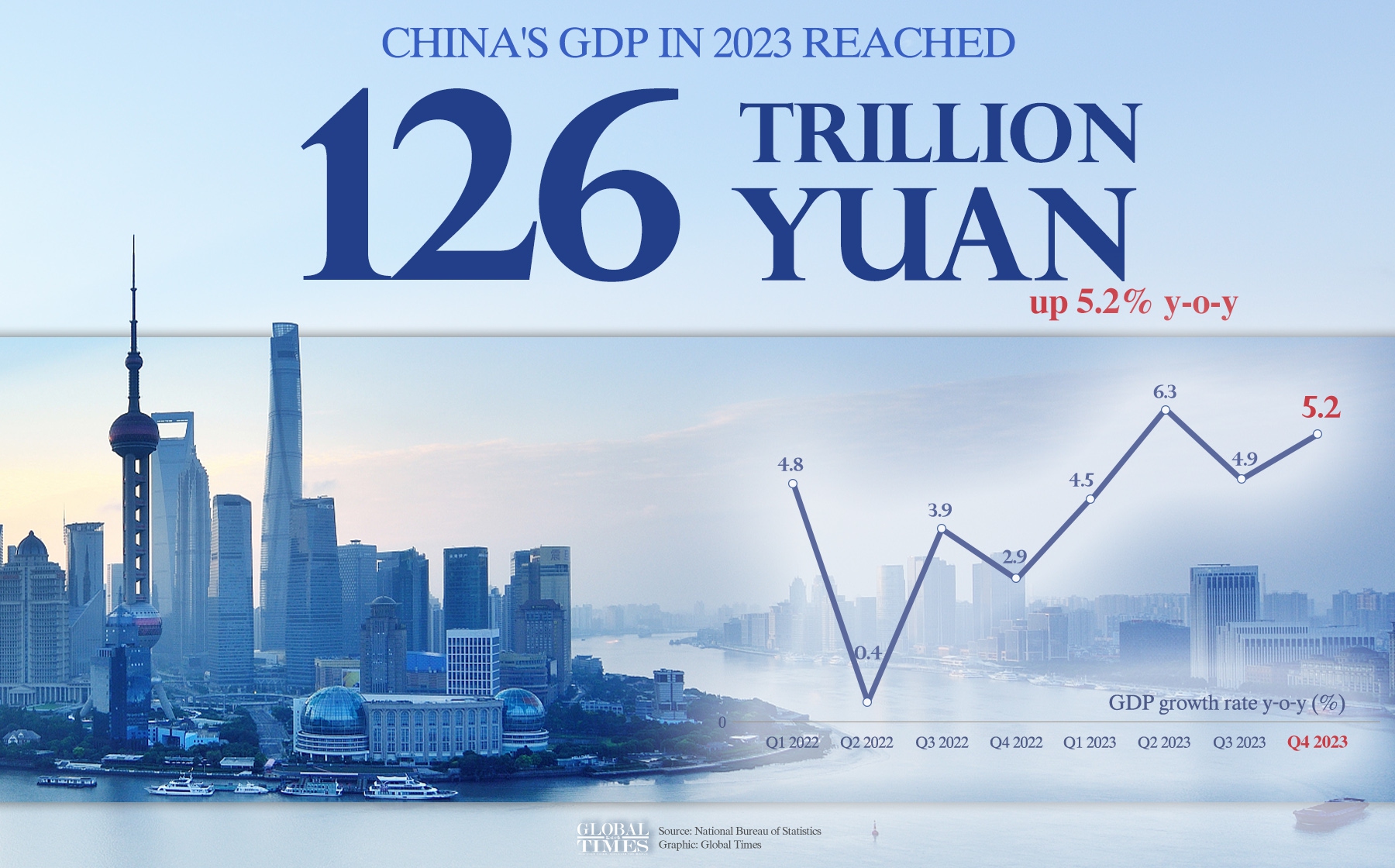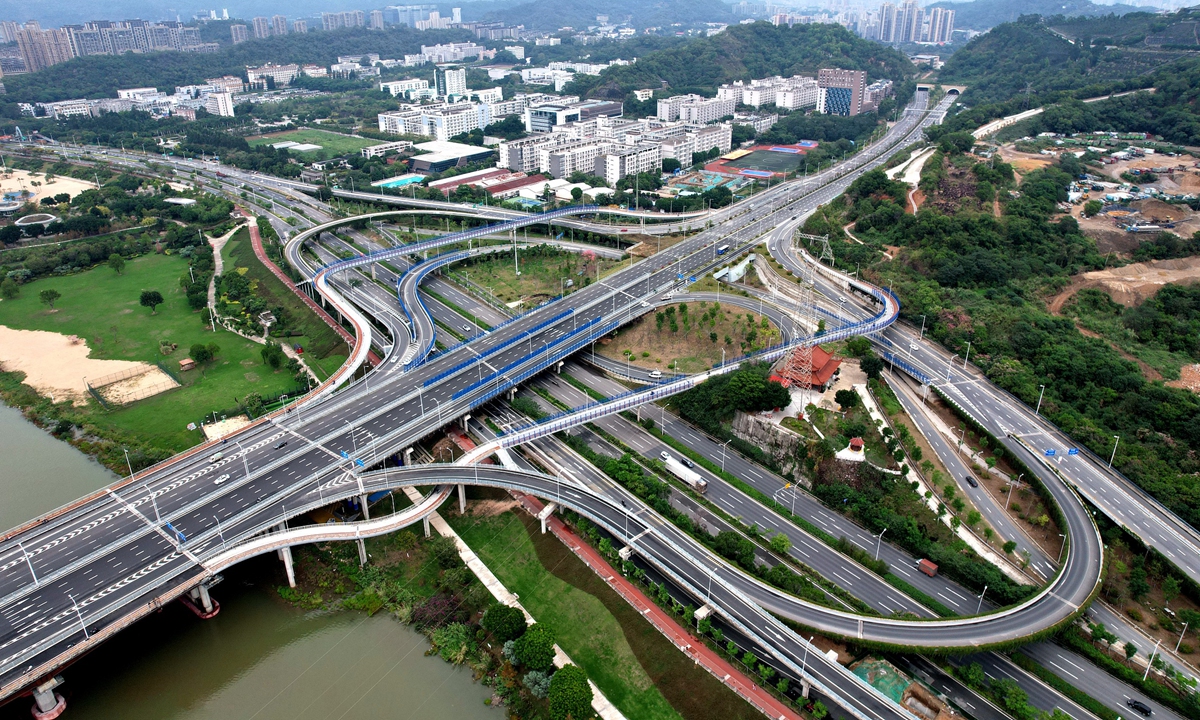
Graphic: Global Times
China on Wednesday posted a robust GDP growth of 5.2 percent for 2023, successfully beating the government's pre-set yearly target of around 5 percent. This highlighted the strong internal dynamics of the world's second-largest economy and its significant potential for continuous expansion, even amid a turbulent international macroeconomic environment, continuing to drive global resurgence.The country's economy particularly achieved a standout performance in the fourth quarter, growing 5.2 percent between October and December. Chinese Premier Li Qiang has already projected a 5.2 percent GDP growth for 2023 during a speech at the World Economic Forum (WEF) annual meeting in Davos on Tuesday.
Despite factors including a slowdown in the real estate industry, China's economy emerged from the shadows of the pandemic over the past 12 months, achieving a remarkably steady growth. Standout achievements included vibrant services sector spending, substantial investments in high-end manufacturing, and notable advancements in foreign trade activities. These compelling data refuted the continuous attempts by certain foreign media outlets to paint a negative picture of China's economic recovery.
Analysts noted that the fundamentals of the Chinese economy remain solid, with new growth drivers continually emerging, while certain risk factors are being steadily addressed by government policies. Despite challenges expected in 2024, there is a positive outlook for the Chinese economy to navigate the choppy waters, ensuring continuous and steady growth.
In 2023, China's annual GDP reached 126.06 trillion yuan ($17.52 trillion), registering a 5.2 percent growth compared to the previous year. Despite stiff headwinds, the national economy demonstrated resilience, achieving a new milestone in overall economic development, according to data released by the National Bureau of Statistics (NBS) on Wednesday.
Bright spots
In terms of industry breakdown, the value added in the primary sector surged to 8.98 trillion yuan, showing a robust 4.1 percent increase from the previous year. The secondary sector contributed significantly with 48.26 trillion yuan, marking a steady growth of 4.7 percent, while the tertiary sector added 68.82 trillion yuan, experiencing a notable 5.8 percent increase.
Looking at the quarterly performance, the year-on-year GDP growth rates were 4.5 percent in the first quarter, 6.3 percent in the second quarter, 4.9 percent in the third quarter, and 5.2 percent in the fourth quarter.
In 2023, China's total grain output reached 1.39 trillion jin (695 billion kilogram), an increase of 1.3 percent over the previous year, consistently exceeding 1.3 trillion jin for the ninth consecutive year.
The annual value-added of the national industrial enterprises above a designated size increased by 4.6 percent compared to the previous year. In particular, that of the equipment manufacturing industry grew by 6.8 percent, 2.2 percentage points higher than that of the overall industrial enterprises above a designated size.
The total retail sales of consumer goods recorded 47.15 trillion yuan, up 7.2 percent year-on-year. Spending in the services sector experienced rapid growth, with a year-on-year retail sales increase of 20 percent .
The annual per capita disposable income of residents nationwide reached 39,218 yuan, marking a nominal growth of 6.3 percent compared to the previous year.
Analysts have taken stock of highlights in the country's economic performance in 2023.
"For starters, it is the commendable and sustained industrial upgrades from medium and low value-added industries to high value-added industries," Tian Yun, an independent macro analyst, told the Global Times on Tuesday.
Tian highlighted automotive, airplane and ship manufacturing as highlights that beat market expectations the most.
In 2023, China's auto production and sales for the first time both exceeded 30 million units, a record high, according to the China Association of Automobile Manufacturers last week. By shipping over 5 million automobiles overseas, the country is estimated to have overtaken Japan as the world's largest auto exporter in 2023.
The annual national fixed-asset investment (excluding rural households) reached 50.3 trillion yuan, showing a growth of 3 percent compared to the previous year. Notably, investment in the manufacturing sector increased by 6.5 percent. The high-tech industry investment emerged as a highlight, growing by 10.3 percent and surpassing the overall investment growth by 7.3 percentage points. Investments in high-tech manufacturing and high-tech services increased by 9.9 percent and 11.4 percent, respectively.
"The second notable highlight is evident in addressing and strengthening the weaknesses or shortcomings [in high-tech sectors]," Tian said.
For instance, in the field of semiconductor technology, China has witnessed a decline in chip imports, yet its domestic production has not only been maintained but has also demonstrated higher efficiency, Tian said, stressing that it was an impressive progress in the face of an ongoing US blockade.
China's global trade position is unassailable. Without the export of high-quality and low-cost technologically advanced products from China, many countries, especially developing and low-income nations, might face even more severe development challenges than they currently do, Tian added.
During a Friday interview with the Global Times, Yu Xiangrong, Citi's chief economist for China, also highlighted the accelerated recovery of spending of services, improvements in the export chain and the rapid development of high-end manufacturing as bright spots in China's performance over the past year.
As the Spring Festival holidays approach, domestic travel, outbound and inbound travel bookings have all witnessed significant growth. For the upcoming holidays, domestic travel bookings have grown over 7 times compared to the previous year, while both outbound and inbound travel bookings have increased by more than 10 times year-on-year, per data sent to the Global Times by online travel agency Trip.com on Tuesday.
On Friday, the General Administration of Customs (GAC) released China's foreign trade data for 2023, revealing trends that exceeded expectations. Total trade grew 0.2 percent year-on-year to 41.76 trillion yuan.
GAC deputy head Wang Lingjun told a press conference that "China's imports and exports performed 'better than expected,' and it is expected to maintain its position as the world's largest goods trading nation for a seventh consecutive year."
According to the World Trade Organization, the international market share of China's exports in 2023 was likely to have remained at a high level of around 14 percent.
Managing risks
While highlighting the lingering challenges, the real estate sector saw its investment decline by 9.6 percent. The national sales area of commercial residential buildings stood at 1.12 billion square meters, reflecting a decrease of 8.5 percent.
Tian noted that the risks associated with local government debt and the real estate sector are entirely manageable. In fact, the levels of indebtedness in the real estate industry to overseas creditors decreased significantly last year, he added, noting that "moreover, there is still sufficient room for further improvement in China's urbanization rate."
"We see the drag by the property sector will likely diminish in 2024," Xing Zhaopeng, senior China strategist with ANZ Research, told the Global Times in a written interview.
Xing further predicted that China is expected to set a GDP growth target of 5 percent for 2024 and "potential growth should still be above 5 percent."
Yu Yongding, academic advisor to the CF40 and Member of the Chinese Academy of Social Sciences, also said in a recent article shared with the Global Times that "In my opinion, the economic growth target for China in 2024 should not be lower than 5 percent."
As the new year begins, efforts are being made to achieve a robust economic start to the year all over the country.
Bustling tourism in Harbin, the capital of Northeast China's Heilongjiang Province, is propelling the rapid recovery of the national cultural and tourism industry. Major projects are being commenced across the country, targeting areas such as improving living standards, advancing infrastructure and urban renewal, and upgrading industries.

